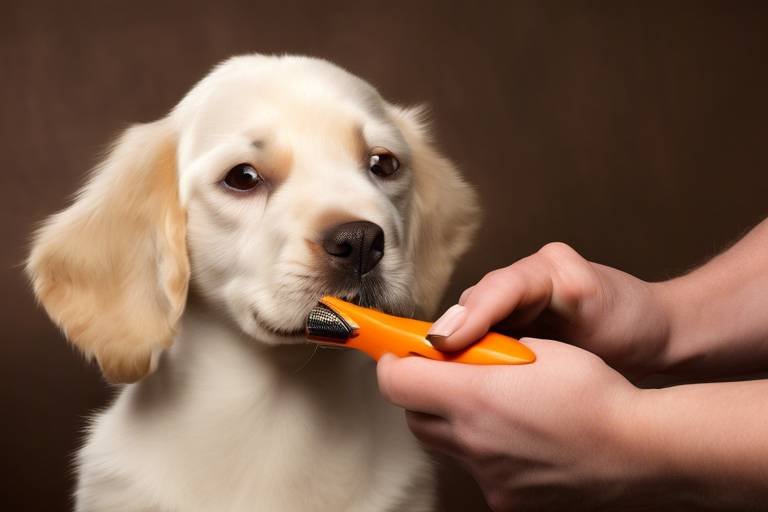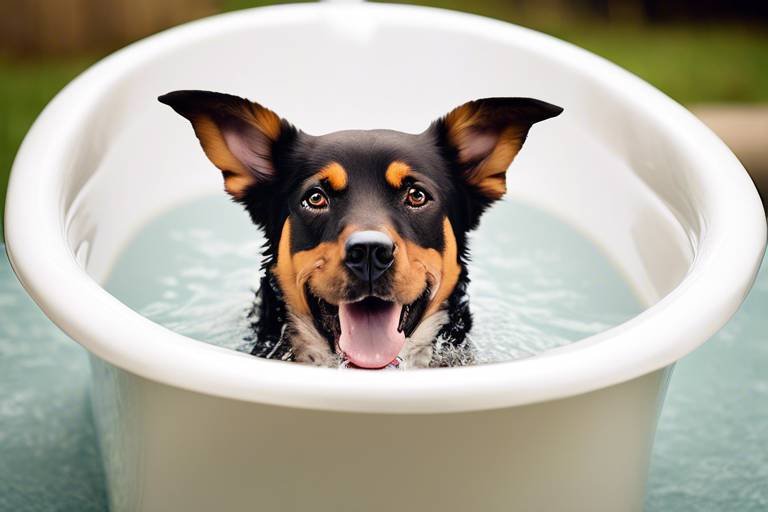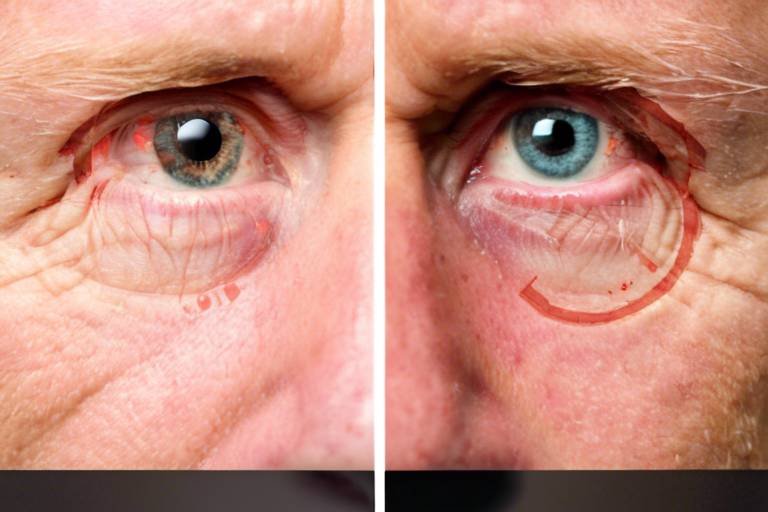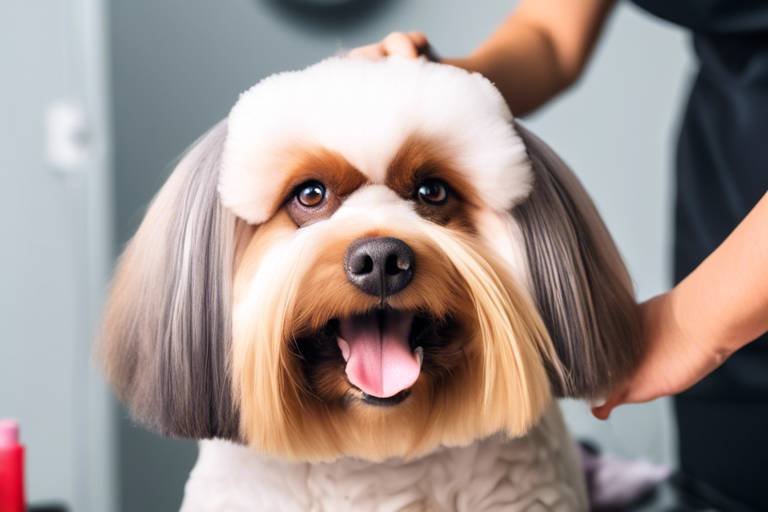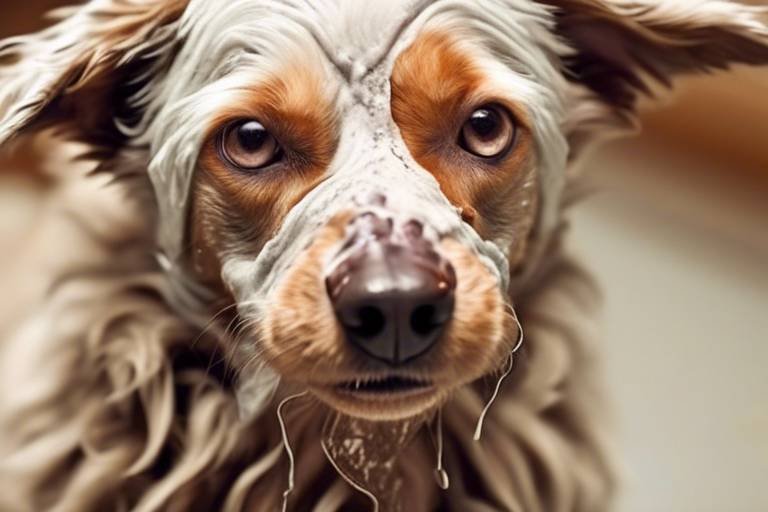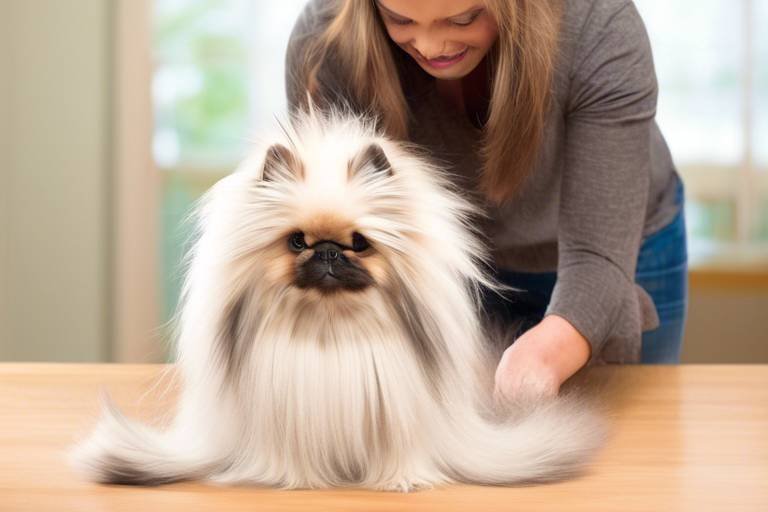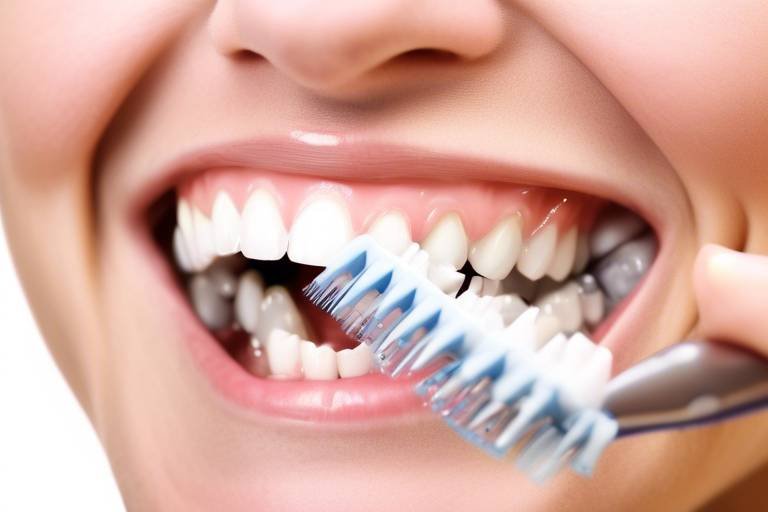How to Train Your Dog to Enjoy Nail Trimming
Have you ever watched your furry friend squirm and pull away when it’s time for nail trimming? It’s a common scenario that many dog owners face, and it can be quite stressful for both you and your pet. But fear not! Training your dog to enjoy, or at least tolerate, nail trimming is entirely possible with the right approach. This article explores effective techniques for training your dog to accept nail trimming without fear or anxiety, ensuring a positive experience for both you and your pet.
Before we dive into the how-tos, let’s take a moment to understand why your dog might be fearful of nail trimming. Dogs often associate grooming with discomfort or past negative experiences. This fear can manifest in various ways, such as whining, hiding, or even aggressive behavior. Recognizing these signs is the first step toward addressing the issue. Remember, your dog’s fear is not just a phase; it’s a genuine feeling that needs to be respected and handled delicately. By understanding your dog’s anxiety, you can create a more comfortable environment that encourages cooperation.
Using the appropriate tools can make a significant difference in your dog's comfort during nail trimming. Just like humans, dogs have different preferences and needs when it comes to grooming tools. It’s essential to choose the right clippers or grinders that suit your dog's size and nail type. The wrong tool can lead to discomfort and may reinforce your dog’s fear of nail trimming. In this section, we will discuss various types of clippers and grinders available on the market, helping you make an informed choice.
Different types of nail clippers suit different dog breeds and sizes. Here’s a quick breakdown of the most common types:
- Guillotine Clippers: These are ideal for small to medium-sized dogs. They work by using a blade that slices through the nail when you squeeze the handle.
- Scissor Clippers: These are more suitable for larger breeds. They resemble scissors and require a bit more strength to use effectively.
- Electric Grinders: These tools can smooth out sharp edges after clipping but require some acclimation for your dog.
Each type has its pros and cons, and the best choice often depends on your dog’s specific needs.
When choosing between guillotine and scissor clippers, consider the following:
| Feature | Guillotine Clippers | Scissor Clippers |
|---|---|---|
| Best For | Small to medium dogs | Large dogs |
| Ease of Use | Easy to handle | Requires more strength |
| Precision | Good for quick cuts | Better for controlled trimming |
Ultimately, the choice comes down to your comfort level and your dog's size. It’s worth trying both types to see which one your dog responds to best.
Nail grinders can be a great alternative to traditional clippers. They offer the advantage of smoothing out rough edges, which can be particularly beneficial for dogs that are prone to splitting their nails. However, they can also be noisy and may require more time to get used to. Here are some pros and cons:
- Pros: Smooths nails, reduces splintering, and can be less intimidating for some dogs.
- Cons: Noise can scare some dogs, and it takes longer than clipping.
Consider your dog’s personality and previous experiences when deciding if a grinder is the right tool for you.
Preparation is key to a successful grooming session. Start by allowing your dog to sniff and explore the clippers or grinder before actually using them. This helps them become familiar with the tools and reduces anxiety. You can also practice handling your dog’s paws regularly, rewarding them with treats and praise to create a positive association.
Creating a positive experience around nail trimming is essential. Dogs are incredibly responsive to their owners' emotions; if you’re anxious, they will be too. Use techniques that associate nail trimming with rewards and praise. For instance, each time you successfully trim a nail, offer a treat or verbal praise. This will help your dog learn that nail trimming isn’t something to fear but rather a part of their grooming routine that comes with rewards.
Incorporating treats and verbal praise can significantly alter your dog's perception of nail trimming. Make sure to have high-value treats on hand, something your dog doesn’t get every day. This makes the reward feel special and encourages them to cooperate. Pair the treats with enthusiastic praise to reinforce the behavior you want to see.
Gradual desensitization can help your dog become more comfortable with nail trimming. Start with short sessions, focusing on just one nail at a time. Gradually increase the number of nails you trim in each session. This method allows your dog to adjust at their own pace and reduces the likelihood of overwhelming them.
Consistency is vital in reinforcing positive behavior. Establishing a regular grooming schedule can help your dog anticipate nail trimming sessions. The more routine it becomes, the less anxious your dog will feel. Make sure to stick to your schedule, even if it means trimming just one nail at a time.
Establishing a grooming routine can help your dog anticipate nail trimming sessions. Choose a specific day and time each week, and make it a fun bonding experience. This will help your dog associate nail trimming with quality time spent with you.
Tracking your dog's progress can help you identify areas that need improvement. Keep a journal of your grooming sessions, noting what worked well and what didn’t. This will also remind you to be patient and persistent in the training process. Remember, every dog is different, and some may take longer to adjust than others.
Q: How often should I trim my dog's nails?
A: It varies by breed and activity level, but generally, every 3-4 weeks is a good rule of thumb.
Q: What if my dog has black nails?
A: Be extra cautious, as it’s harder to see the quick. Trim small amounts at a time to avoid cutting too deep.
Q: Can I use human nail clippers?
A: It’s not recommended. Dog nail clippers are designed specifically for their nails and are safer.

Understanding Your Dog's Fear
Every dog is unique, and just like humans, they can have their own fears and anxieties. Understanding your dog's fear of nail trimming is the first step in helping them overcome it. Many dogs associate nail trimming with discomfort or even pain, which can stem from past experiences or simply from the unfamiliarity of the process. It's essential to recognize that these fears are not just behavioral quirks; they are genuine feelings that can manifest in various ways. For instance, some dogs may become anxious and try to escape, while others might freeze in place, their body language screaming discomfort.
Common reasons behind a dog's fear of nail trimming include:
- Previous Negative Experiences: If your dog has ever had a painful experience during a nail trim, they may associate the process with that discomfort.
- Unfamiliar Sounds: The sound of nail clippers or grinders can be alarming. Dogs have sensitive hearing, and the noise can trigger anxiety.
- Physical Restraint: Some dogs feel trapped when held in place for grooming, leading to panic or fear.
- Uncertainty: Dogs thrive on routine, and if nail trimming is not a regular part of their life, they may feel uneasy about what to expect.
It's crucial to observe your dog's behavior during grooming sessions. Signs of fear can include:
- Trembling or shaking
- Whining or barking
- Attempting to escape or hide
- Excessive drooling or panting
By paying attention to these signs, you can better understand your dog's emotional state and tailor your approach accordingly. Acknowledging these fears is not a sign of weakness; rather, it's a step toward creating a more positive experience for both you and your furry friend. The goal is to transform nail trimming from a dreaded chore into a routine that your dog can accept and even enjoy.

Choosing the Right Tools
When it comes to trimming your dog's nails, choosing the right tools is not just a matter of convenience; it can significantly influence your dog's comfort and the overall success of the grooming session. Imagine trying to cut a piece of paper with dull scissors—it’s frustrating, right? The same principle applies to your dog's nails. Using the correct tools can make the process smoother and less stressful for both of you. So, what should you look for in nail trimming tools? Let's dive into the various types available on the market.
There are primarily two types of nail clippers that pet owners gravitate towards: clippers and grinders. Each has its unique advantages and disadvantages, and understanding these can help you make an informed choice. For instance, nail clippers come in various designs, including guillotine and scissor types, while nail grinders offer a different approach altogether. But how do you know which one is right for your furry friend?
Different breeds and sizes of dogs may require different types of nail clippers. Here’s a quick breakdown:
| Type | Pros | Cons |
|---|---|---|
| Guillotine Clippers | Easy to use, good for small to medium dogs | Can be difficult for larger dogs, risk of crushing the nail |
| Scissor Clippers | Great for larger breeds, provides more control | Requires more strength, may not be suitable for small dogs |
Now that you have a clearer idea of the types of clippers, let’s discuss nail grinders. These tools can be a great alternative to traditional clippers. They work by grinding down the nail rather than cutting it, which can be less stressful for some dogs. However, there are pros and cons to consider as well.
Nail grinders can offer a safer option for nail trimming, especially for dogs who are particularly anxious. The smooth finish can help prevent snagging on carpets or furniture, which is a common issue with clipped nails. However, they can also be noisy and may take longer to use than traditional clippers. It’s essential to consider your dog's temperament when deciding whether to use a grinder.
Ultimately, the right tool will depend on your dog's size, breed, and individual personality. Always remember that the goal is to make nail trimming a positive experience. So, whether you choose clippers or grinders, ensure they are of high quality and comfortable for both you and your furry friend.
Types of Nail Clippers
When it comes to trimming your dog's nails, choosing the right clippers is essential for both comfort and effectiveness. Different types of nail clippers cater to various dog breeds and sizes, and understanding these options can make a significant difference in your grooming experience. Let's delve into the most common types of nail clippers available in the market, highlighting their pros and cons so you can make an informed decision.
The two most popular types of nail clippers are guillotine clippers and scissor clippers. Each type has its unique features and benefits, which can affect how well they work for your furry friend. For instance, guillotine clippers have a blade that moves in a guillotine-like motion, allowing for precise cuts. They are generally favored for smaller breeds because they offer excellent control and require less force. However, they may not be suitable for larger dogs due to their design and the amount of pressure needed to make a clean cut.
On the other hand, scissor clippers resemble a pair of scissors and are ideal for larger breeds. They provide more leverage and can handle tougher nails, making them a popular choice among dog owners with bigger pups. However, they require a bit more skill to use effectively, and if you're not careful, there's a risk of crushing the nail rather than cutting it cleanly. This can lead to discomfort for your dog, which is something we want to avoid at all costs!
| Type of Clipper | Best For | Pros | Cons |
|---|---|---|---|
| Guillotine Clippers | Small to Medium Breeds |
|
|
| Scissor Clippers | Medium to Large Breeds |
|
|
In addition to these two types, nail grinders are another option worth considering. They work by sanding down the nails rather than cutting them, which can be less intimidating for some dogs. However, they do have their drawbacks, such as the noise they make, which might scare your pet. Ultimately, the choice of nail clippers should align with your dog's size, temperament, and your comfort level as a groomer.
So, whether you opt for guillotine clippers, scissor clippers, or a nail grinder, remember that the goal is to make the nail trimming process as stress-free as possible for your furry friend. After all, a happy dog leads to a happy owner!
Guillotine vs. Scissor Clippers
When it comes to trimming your dog's nails, choosing the right tool can make all the difference. Two popular options are guillotine clippers and scissor clippers. Each type has its own unique features and benefits, so it's essential to understand their differences to select the best one for your furry friend.
Guillotine clippers are designed with a blade that moves in a guillotine-like motion. This means that when you squeeze the handle, the blade slides down and cuts the nail. They are generally easier to use for those who are new to dog grooming because they offer a clear view of the nail as you trim. However, they can sometimes require more pressure, which might make some dogs uncomfortable. On the other hand, scissor clippers resemble a pair of scissors and are often favored for their versatility. They can be more suitable for larger breeds or dogs with thicker nails, as they can deliver a clean cut with less effort.
To help you decide between the two, here’s a quick comparison:
| Feature | Guillotine Clippers | Scissor Clippers |
|---|---|---|
| Ease of Use | Simple for beginners | Requires a bit more skill |
| Best For | Small to medium breeds | Large breeds with thick nails |
| Cutting Action | Guillotine motion | Scissor-like action |
| Comfort Level | Can require more pressure | Less pressure needed for a clean cut |
Ultimately, the choice between guillotine and scissor clippers will depend on your dog's size, nail thickness, and your personal comfort level with each tool. It's often a good idea to try both types to see which one feels more comfortable for you and your pup. Remember, a positive nail trimming experience is key to keeping your dog calm and cooperative during grooming sessions!
- How often should I trim my dog's nails? It typically depends on your dog's activity level and the type of surfaces they walk on. Generally, every 3-4 weeks is a good rule of thumb.
- What if my dog is scared of nail trimming? Gradual desensitization and positive reinforcement can help ease their anxiety. Start slowly and reward them for calm behavior.
- Can I use human nail clippers on my dog? While it's possible, it's not recommended as they may not be designed for the thickness of dog nails and can cause discomfort.
Nail Grinders: Pros and Cons
Nail grinders have become a popular alternative to traditional nail clippers, and for good reason. They offer a different approach to nail trimming that can be less intimidating for both you and your furry friend. However, before you decide to make the switch, it’s essential to weigh the pros and cons of using a nail grinder.
One of the significant advantages of nail grinders is their ability to provide a smoother finish on your dog's nails. Unlike clippers, which can sometimes cause splintering or cracking, grinders gently file down the nail, reducing the risk of discomfort. This is particularly beneficial for dogs with thick or tough nails, as it allows for more control during the trimming process. Additionally, many pet owners find that grinders can be less stressful for their pets, as the noise from the grinder can be less startling than the sound of clippers snipping away.
However, there are some drawbacks to consider as well. For instance, nail grinders can take longer to use compared to traditional clippers. If you have a dog that is particularly anxious or restless, the extended time spent grinding their nails might lead to increased stress for both of you. Moreover, some dogs may not be accustomed to the sensation of a grinder, which can lead to fear or resistance. It's essential to introduce the grinder gradually and patiently to avoid overwhelming your pet.
Here's a quick comparison of the pros and cons:
| Pros | Cons |
|---|---|
|
|
Ultimately, the decision to use a nail grinder should be based on your dog's personality and your own comfort level with the tool. If you decide to give it a try, make sure to choose a grinder that suits your dog's size and nail type. With a little patience and practice, you might find that nail grinders are a fantastic addition to your grooming toolkit!
As you delve into the world of dog grooming, you may have some questions about nail trimming and the use of grinders. Here are a few common inquiries:
- How often should I trim my dog's nails? It typically depends on the dog's activity level and lifestyle, but most dogs need nail trimming every 3-4 weeks.
- Can I use a human nail grinder on my dog? It's best to use a grinder designed specifically for pets, as they are more suitable for the thickness and sensitivity of dog nails.
- What should I do if my dog is afraid of the grinder? Gradually introduce the tool, starting with short sessions and rewarding your dog with treats to create a positive association.
Preparing Your Dog for Nail Trimming
Preparation is the cornerstone of a successful nail trimming session. Just like you wouldn’t want to jump into a cold pool without first dipping your toes in, your dog needs to be gradually introduced to the idea of nail trimming. Start by creating a calm and relaxing environment where your dog feels safe. Consider this: if your dog associates nail trimming with stress, it will be a battle every time. Instead, let’s turn that frown upside down!
Begin by getting your dog accustomed to having their paws handled. This can be done by gently massaging their paws during playtime or while they’re lounging around. You want to make it a positive experience, so keep the mood light and fun. Use a soft voice and offer plenty of pets and scratches. You might even consider using a treat jar as a tool for positive reinforcement. Every time your dog allows you to touch their paws, reward them with a tasty treat. It’s all about building that trust!
Next, introduce the nail clippers or grinder without actually using them at first. Let your dog sniff and explore the tools at their own pace. You could place the tools near their favorite resting spot, allowing them to become familiar with the sight and smell. Remember, the goal here is to eliminate any anxiety related to the tools. This is akin to letting a child play with a toy before asking them to use it. They need to feel comfortable first!
Once your dog seems relaxed with the clippers, it's time for a little mock session. Gently hold their paw and pretend to trim their nails without actually cutting anything. This step is crucial as it helps your dog understand the process without the pressure of the actual trimming. You can do this for a few seconds at a time, gradually increasing the duration as your dog becomes more comfortable. Think of it as a dress rehearsal before the big show!
Finally, remember that patience is key. If your dog shows signs of stress or anxiety, take a step back and give them a break. You want to make nail trimming a positive experience, not a dreaded chore. Use calming techniques such as soft music or a favorite blanket to help soothe your dog. With time and consistent practice, your dog will learn that nail trimming is just another part of their grooming routine, and who knows, they might even come to enjoy it!

Establishing a Positive Association
Creating a positive experience around nail trimming is essential for reducing your dog's anxiety. Think of it like training for a big game; if your dog associates nail trimming with fun and rewards, they'll be much more willing to participate. The goal here is to shift their perception from fear to excitement. This can be achieved through a combination of treats, praise, and a little bit of patience. It’s all about making nail trimming a rewarding experience rather than a dreaded chore.
Start by introducing your dog to the nail clippers or grinder when they are calm and relaxed, perhaps during a quiet time at home. Allow them to sniff the tools, and reward them with a treat for being curious. This initial introduction is crucial; you want your dog to see the clippers as something positive rather than a scary object. You can even take it a step further by letting them hear the sound of the clippers or grinder without actually using them on their nails. This will help desensitize them to the noise.
Next, incorporate treats and verbal praise during the grooming process. For instance, every time you successfully trim a nail, shower your dog with praise and give them a treat. This creates a strong association in their mind: nail trimming yummy treats + happy owner. Over time, your dog will begin to look forward to nail trimming sessions, knowing they will be rewarded for their cooperation.
Additionally, you can use a method called gradual desensitization. This involves breaking down the nail trimming process into smaller, manageable steps. Start by simply handling your dog's paws and rewarding them for being still. Once they are comfortable with that, move on to touching the clippers to their nails without cutting. Gradually increase the intensity of the experience until you are able to trim their nails without any fuss. Remember, the key is to move at your dog's pace; if they seem uncomfortable, take a step back and give them more time to adjust.
In conclusion, establishing a positive association with nail trimming is all about creating a fun and rewarding environment. By using treats, praise, and gradual desensitization, you can help your dog feel more comfortable and even excited about getting their nails trimmed. So, roll up your sleeves, grab those clippers, and get ready to turn a once-dreaded task into a bonding experience!
- How often should I trim my dog's nails? - Typically, every 3-4 weeks is ideal, but it can vary based on your dog's activity level and nail growth.
- What if my dog hates having their nails trimmed? - Start with positive reinforcement techniques and gradual desensitization to help them become more comfortable.
- Can I use human nail clippers on my dog? - It's best to use tools specifically designed for dogs to ensure safety and effectiveness.
- What should I do if I accidentally cut too short? - If you cut into the quick, apply a styptic powder to stop the bleeding and comfort your dog.
Using Treats and Praise
When it comes to training your dog to enjoy nail trimming, can be a game changer. Imagine this: your dog sees the nail clippers and instantly thinks of tasty treats and enthusiastic praise. Sounds like a dream, right? Well, it can be your reality with the right approach! By incorporating positive reinforcement into your grooming routine, you can transform what was once a dreaded chore into a fun and rewarding experience for both you and your furry friend.
To start, it’s essential to choose the right treats. Look for something that your dog absolutely loves—perhaps a special biscuit or a piece of their favorite protein. The key is to make these treats exclusive to nail trimming sessions, so they become a high-value reward. This exclusivity will help your dog associate the clippers with something positive. Each time you bring out the clippers, they should be looking at you with wide, hopeful eyes, anticipating those delicious rewards!
During the grooming session, consistency is crucial. Begin by letting your dog sniff the clippers while offering treats. This simple act helps to desensitize them to the tool. Once they’re comfortable with the clippers, you can gradually move to touching their paws. Make sure to shower them with praise and treats every step of the way. It’s like a dance—you lead, and your dog follows, learning to trust you more with each positive interaction.
Here’s a quick breakdown of how to effectively use treats and praise during nail trimming:
- Introduce the Tools: Allow your dog to explore the clippers or grinder while offering treats.
- Touching the Paws: Gently handle their paws and reward them with treats and praise.
- Short Sessions: Keep initial trimming sessions brief to avoid overwhelming your dog.
- Celebrate Small Victories: Even if you only manage to clip one nail, celebrate it! Your dog will appreciate the recognition.
Remember, the goal is to create a positive association with nail trimming. If your dog seems anxious or resistant, take a step back and give them a moment. Rushing the process can lead to negative experiences, which may undo all your hard work. Instead, keep the atmosphere light and fun, and always be generous with your treats and praise. With patience and consistency, your dog will not only tolerate nail trimming but may even start to look forward to it!
Q: How long should I train my dog for nail trimming?
A: Training sessions should be short and sweet, ideally around 5-10 minutes. The key is to keep your dog engaged without overwhelming them.
Q: What if my dog still seems scared after several sessions?
A: It's important to be patient. If your dog is still fearful, consider breaking the process down into even smaller steps and celebrating every little achievement.
Q: Can I use regular treats for training?
A: Yes, but it's best to use high-value treats that your dog doesn’t get often. This makes the reward more enticing and helps strengthen the positive association.
Q: How often should I trim my dog's nails?
A: This varies by breed and activity level, but generally, every 3-4 weeks is a good rule of thumb. Regular trimming can help maintain your dog's comfort and health.
Gradual Desensitization Techniques
Gradual desensitization is a powerful technique that can transform your dog's perception of nail trimming from a dreaded chore into a more tolerable experience. The key to this method is to take it slow and allow your dog to adjust at their own pace. Just like how we might feel anxious about public speaking, dogs can have their own fears, and it's essential to ease them into the process.
Start by introducing your dog to the nail clippers or grinder without any intention of actually trimming their nails. Let them sniff the tools and get used to their presence. This step is crucial because it helps to build familiarity. You might want to hold the clippers in front of them while offering treats and verbal praise. This creates a positive association with the tools, making them less intimidating.
Once your dog seems comfortable with the sight and smell of the clippers, you can gradually progress to touching their paws. Start by gently holding one of their paws and massaging it. This not only helps them get used to having their paws handled but also builds trust between you and your furry friend. If your dog shows signs of discomfort, such as pulling away or whining, take a step back and repeat the previous steps until they feel more at ease.
After your dog is comfortable with having their paws touched, you can introduce the sound of the clippers. Try turning them on while your dog is in a relaxed state, perhaps during a play session or while they are lounging. Again, reward them with treats and praise to reinforce a positive experience. You can gradually progress to mimicking the clipping motion without actually cutting their nails. This way, your dog can get used to the sensation without the pressure of a full grooming session.
As you continue this process, you can start to trim just the tip of one nail. Celebrate this small victory with lots of praise and treats! Remember, patience is key. If your dog becomes anxious at any point, take a step back and repeat the previous stages until they regain their confidence. Over time, you can gradually increase the number of nails you trim in a single session.
To help visualize the gradual desensitization process, here's a simple table:
| Step | Action | Goal |
|---|---|---|
| 1 | Introduce clippers | Familiarity with tools |
| 2 | Touch paws gently | Comfort with handling |
| 3 | Introduce sound of clippers | Desensitize to noise |
| 4 | Mimic clipping motion | Prepare for actual trimming |
| 5 | Trim one nail | Start the actual process |
By following these gradual desensitization techniques, you can help your dog feel more relaxed and confident during nail trimming sessions. Remember, the goal is to foster a positive environment where your dog feels safe and secure. With time, patience, and a lot of love, nail trimming can become just another part of your grooming routine!
Q: How long does it take for a dog to get used to nail trimming?
A: The time it takes varies by dog. Some may adapt within a few sessions, while others may need weeks or even months. Consistency and patience are essential!
Q: What if my dog still shows fear after several attempts?
A: If your dog is still anxious, consider consulting a professional dog trainer or a veterinarian for additional strategies tailored to your dog's needs.
Q: Are there any calming products that can help?
A: Yes! There are calming sprays, treats, and even anxiety wraps that can help soothe your dog before nail trimming sessions.

Maintaining Consistency in Training
When it comes to training your dog, especially for something as sensitive as nail trimming, consistency is key. Imagine trying to learn a new skill without regular practice; it would be chaotic, right? The same principle applies to our furry friends. By establishing a consistent routine, you help your dog anticipate grooming sessions, making the process less stressful for both of you. If your dog knows when to expect nail trimming, they are less likely to resist or panic when the time comes.
One effective way to maintain consistency is to set a grooming schedule that aligns with your dog's needs. Depending on your dog's breed and activity level, you might find that trimming their nails every two to four weeks works best. Mark these dates on your calendar, and treat them like important appointments. This way, your dog will begin to associate specific days with nail trimming, creating a rhythm that they can adapt to.
Moreover, it's essential to keep the environment the same during each grooming session. Try to use the same space, tools, and even your own demeanor. Dogs are incredibly perceptive and can pick up on your emotions. If you approach nail trimming with calmness and confidence, your dog is more likely to mirror that attitude. If you feel anxious or rushed, your dog may sense this and become anxious themselves. So, take a deep breath, and remember that patience is your best friend in this journey.
Another aspect of maintaining consistency is to monitor your dog's progress closely. Keep a journal or a simple checklist to track how they respond to each session. Are they getting more comfortable? Are there specific techniques or tools that seem to work better? By jotting down your observations, you can tailor your approach to better suit your dog's individual needs. This not only helps in refining your technique but also reinforces your commitment to your dog's grooming routine.
Lastly, don't forget to celebrate the small victories! Each successful nail trimming session is a step forward. Reward your dog with treats, praise, or even playtime afterward. This positive reinforcement not only encourages good behavior but also strengthens the bond between you and your furry companion. Remember, the goal is to create a pleasant experience that both you and your dog look forward to.
- How often should I trim my dog's nails? - Most dogs need their nails trimmed every 2-4 weeks, but this can vary based on breed and activity level.
- What if my dog is still scared of nail trimming? - Continue to use positive reinforcement and gradual desensitization techniques to help them feel more comfortable.
- Can I use human nail clippers on my dog? - It's best to use clippers specifically designed for dogs, as they are safer and more effective.
- What should I do if I accidentally cut too short? - If you cut into the quick, apply a styptic powder to stop the bleeding and soothe your dog.
Setting a Routine
Establishing a grooming routine is one of the most effective ways to help your dog become comfortable with nail trimming. Think of it as creating a predictable schedule that your furry friend can rely on. Just like humans thrive on routines, dogs also feel more secure when they know what to expect. So, how do you go about setting this routine? Well, it starts with consistency. Choose specific days and times each week dedicated to grooming, and stick to them. This not only helps your dog anticipate the nail trimming sessions but also reinforces the idea that it’s a normal part of their life.
When setting a routine, consider your dog's natural behavior and energy levels. For example, if your dog tends to be more relaxed in the evening, that might be the perfect time for nail trimming. You wouldn’t want to tackle this task when your pup is bouncing off the walls, right? Moreover, keep the sessions short and sweet, especially in the beginning. Aiming for about 10-15 minutes can prevent your dog from feeling overwhelmed. Over time, as your dog becomes more accustomed to the routine, you can gradually extend the duration of the sessions.
Another aspect to consider is the environment. Make sure to create a calm and quiet space for grooming. This could be a specific room in your house or even a cozy spot in the backyard. Ensure that there are no distractions, as this will help your dog focus on the task at hand. You might also want to incorporate some calming music or white noise to further ease any anxiety. By establishing a consistent routine in a peaceful setting, you’re not just grooming your dog; you’re building trust and making the experience a positive one.
To help reinforce the routine, you can create a simple schedule that outlines your grooming days. Here’s a quick example:
| Day | Activity |
|---|---|
| Monday | Nail Trimming |
| Wednesday | Brushing and Bathing |
| Friday | Nail Trimming |
Feel free to adjust the schedule according to your needs. Just remember, the goal is to create a consistent pattern that your dog can get used to. Over time, your dog will begin to associate nail trimming with a regular, non-threatening activity, making it much easier for both of you.
Monitoring Progress
Monitoring your dog's progress during nail trimming training is not just a good idea; it's essential for ensuring that both you and your furry friend feel comfortable throughout the process. Just like humans, dogs can have varying responses to training, and being observant can make all the difference. You might wonder, how do you know if your training techniques are working? Well, let's dive into some key indicators that can help you gauge your dog's comfort level.
First and foremost, keep an eye on your dog's body language. Signs of relaxation, such as a wagging tail or a calm demeanor, indicate that your dog is becoming more comfortable with the nail trimming process. Conversely, if you notice signs of stress, such as panting, whining, or trying to escape, it may be time to take a step back and reassess your approach. Remember, patience is key! Each dog is unique and may take different amounts of time to adjust.
Another effective way to monitor progress is to maintain a training journal. This doesn’t have to be anything fancy; just jot down notes after each grooming session. Record your dog's behavior, the duration of the session, and any specific techniques you used. Over time, you'll be able to see patterns and improvements. For example, you might notice that your dog is more relaxed after a few sessions or that they respond better to treats than verbal praise. This information can be invaluable for adjusting your training methods.
Additionally, consider using a simple progress tracking table to visualize your dog's journey. Here’s a quick example of what that could look like:
| Date | Duration of Session | Dog's Behavior | Techniques Used |
|---|---|---|---|
| 01/01/2023 | 5 minutes | Calm | Treats, Gentle Praise |
| 01/08/2023 | 10 minutes | Some Anxiety | Short Sessions, Breaks |
| 01/15/2023 | 15 minutes | Relaxed | Gradual Desensitization |
By consistently tracking your dog’s progress, you’ll not only be able to celebrate small victories but also identify when to introduce new techniques or adjust your approach. Remember, it’s all about creating a positive experience for your dog, and monitoring their progress can help you achieve just that. As you continue this training journey, keep in mind that every dog is different, and what works for one may not work for another. Be flexible, be patient, and above all, be loving!
- How often should I trim my dog's nails? It varies by breed, but generally, every 3-4 weeks is a good rule of thumb.
- What should I do if my dog becomes aggressive during nail trimming? It’s best to stop immediately and consult a professional trainer or veterinarian.
- Can I use human nail clippers on my dog? It’s not recommended as they may not be designed for the thickness of dog nails.
- What if my dog won’t accept treats during grooming? Try using their favorite toy or a different type of treat to see if that helps.
Frequently Asked Questions
- Why does my dog fear nail trimming?
Many dogs experience fear during nail trimming due to past negative experiences, unfamiliar sounds of clippers, or simply the sensation of having their paws handled. Understanding these fears is the first step in addressing them effectively.
- What tools are best for trimming my dog's nails?
The best tools vary depending on your dog's size and comfort. Popular options include guillotine clippers, scissor clippers, and nail grinders. Each has its pros and cons, so it’s essential to choose one that suits your dog’s needs and your comfort level.
- How can I prepare my dog for nail trimming?
Preparation involves gradually introducing your dog to the tools and the process. Start by letting them sniff the clippers or grinder, then gently handle their paws without trimming. This gradual exposure helps reduce anxiety.
- What are some effective ways to create a positive association with nail trimming?
Using treats and praise is a fantastic way to create a positive experience. Reward your dog with their favorite treats and lots of verbal praise during and after the nail trimming process to reinforce good behavior.
- How often should I trim my dog's nails?
Generally, dogs should have their nails trimmed every 3 to 4 weeks, but this can vary based on their activity level and natural wear. Regular trimming helps prevent overgrowth and discomfort for your pet.
- What if my dog still resists nail trimming?
Patience is key! If your dog continues to resist, consider gradual desensitization techniques. Start with short sessions, and gradually increase the duration as your dog becomes more comfortable.
- Can I use a nail grinder instead of clippers?
Yes, nail grinders can be a great alternative to clippers. They often provide a smoother finish and can be less intimidating for some dogs. However, it’s essential to introduce them slowly to avoid overwhelming your pet.
- What should I do if I accidentally cut my dog's nail too short?
If you accidentally cut too short, it can cause bleeding. Apply a styptic powder to help stop the bleeding and comfort your dog. If bleeding persists, consult your veterinarian for further assistance.
- How can I monitor my dog's progress during nail trimming training?
Keep a journal of each grooming session, noting your dog's reactions and any improvements. This will help you track progress and determine what techniques work best for your furry friend.

